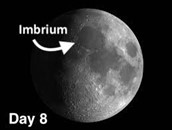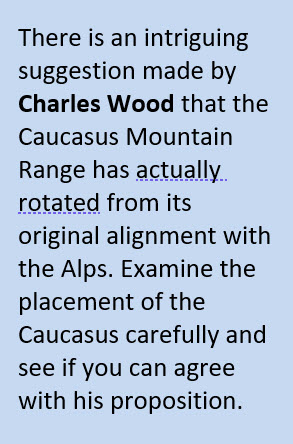The week of June 26-July 2nd takes us from Day 8 to Day 14. This week we will highlight Mare Imbrium on the moon, which should be 80% visible on Tuesday evening.
 The Moon has now entered its gibbous phase and the terminator has become convex toward the west1. Days 7 and 8 present the observer with a cornucopia of detail! At the beginning of Day 8 the terminator will have just cleared Plato, Eratosthenes, and Tycho–a profitable time to observe all three craters. This is also a good opportunity to observe wrinkle ridges that you can see around the eastern side of Mare Imbrium running from Archimedes toward Plato. Many of these wrinkle ridges reveal the presence of hidden mountain ranges, now almost completely buried by lava flows, which formed the inner ring surrounding the impact zone when the Imbrium basin was formed.
The Moon has now entered its gibbous phase and the terminator has become convex toward the west1. Days 7 and 8 present the observer with a cornucopia of detail! At the beginning of Day 8 the terminator will have just cleared Plato, Eratosthenes, and Tycho–a profitable time to observe all three craters. This is also a good opportunity to observe wrinkle ridges that you can see around the eastern side of Mare Imbrium running from Archimedes toward Plato. Many of these wrinkle ridges reveal the presence of hidden mountain ranges, now almost completely buried by lava flows, which formed the inner ring surrounding the impact zone when the Imbrium basin was formed.
Mare Imbrium: [±NW/F8; L=4°W] The Imbrium basin was created 3.9 billion years ago when an asteroid 60 miles in diameter slammed into the Moon at 10 miles per second and blasted out a 720-mile-wide crater! It was at one time a spectacular multi-ring basin like Mare Orientale (Day 13). Fortunately, segments of the original multi-ring features remain in the form of four stunning mountain ranges: the Alps, the Caucasus, the Apennines, and the Carpathians [±F10].
 Unlike mountain ranges on the Earth, these ranges did not form by tectonic uplift; they were blasted into place by the impact that excavated Mare Imbrium (much like a billiard ball dropped into a tub of thick, viscous mud will leave a conspicuous circle of ridges around the point of impact). The Imbrium basin later filled up with lava that had the viscosity of hot maple syrup and therefore flowed very quickly, turning the mare basins into what were truly, for a time, liquid seas. (Early observers of the Moon weren’t so far off base after all when they called these features “seas.”)
Unlike mountain ranges on the Earth, these ranges did not form by tectonic uplift; they were blasted into place by the impact that excavated Mare Imbrium (much like a billiard ball dropped into a tub of thick, viscous mud will leave a conspicuous circle of ridges around the point of impact). The Imbrium basin later filled up with lava that had the viscosity of hot maple syrup and therefore flowed very quickly, turning the mare basins into what were truly, for a time, liquid seas. (Early observers of the Moon weren’t so far off base after all when they called these features “seas.”)
Notice that the Alps have a smaller radius than the other three ranges. That’s because they are part of the original middle ring. The Caucasus, Apennines, and Carpathians form the outer ring. The highest mountain in this outer ring rises to over 18,000 feet (almost 3½ miles—providing the best skiing in the solar system!).
1 Gibbous: more than half but less than full.
======================
It is highly recommended that you get a copy of Sky and Telescope’s Field Map of the Moon, the very finest Moon map available for use at the telescope. It is available for $10.95 at www.skyandtelescope.com and on Amazon. All features mentioned in this blog will be keyed to the grid on the Field Map and will look like this: Plato: [NW/D9]
Credits:
Courtesy of Gray Photography of Corpus Christi, Texas
Lunar photos: NASA / USGS / BMDO / LROC / ASU / DLR / LOLA / Moon Globe. Used by permission
- Rupes Cauchy: A Best Known Fault on the Moon - July 22, 2024
- Moon Crater Schickard – Crater Floor has Stripes - July 15, 2024
- Moon Craters Langrenus and Vandelinus - July 8, 2024